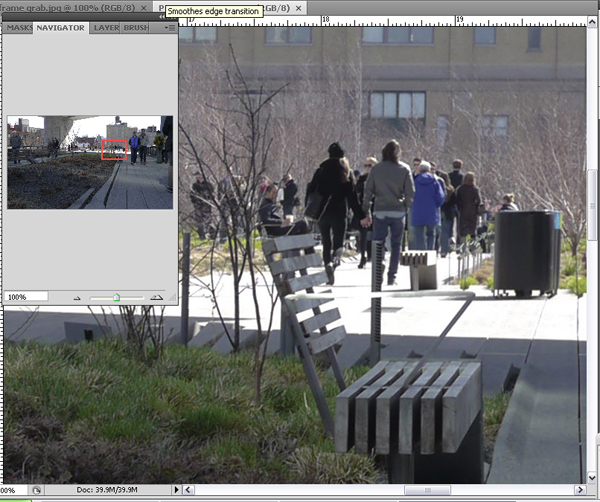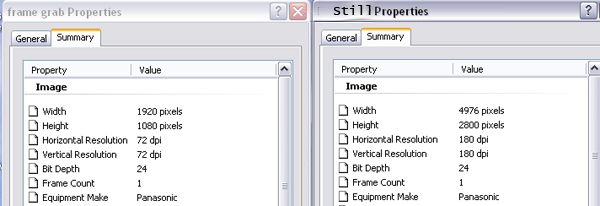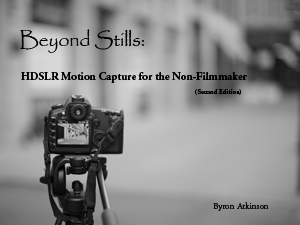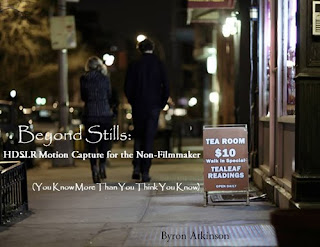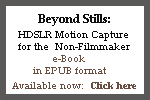Whether you are shooting stills or movies, every HDSLR/ILML camera requires that you choose an image color profile (ICP). It’s called by different names by the various camera makers (Canon – Picture Style; Nikon – Picture Control; Panasonic – Film Mode, by way of example,) but it does the same thing; imparts basic color characteristics to your still and video capture. Typically you will have a standard profile, a more vivid option, and a less vivid option (neutral,) a landscape option optimized for greenery and sky, and a monochrome option among others. A growing number of cameras feature a set of creative filters which can be applied to both stills and video capture. Choosing an ICP for your video footage is as important as your decision as to what frame rate to use.
The selection of an ICP often comes down to a matter of personal taste and intent. Whichever ICP you select, using an appropriate white balance setting for the lighting conditions you are shooting under is key. In choosing your color settings, your subject matter and your intentions should guide your selection. If you are going for somber and brooding, a vivid ICP is probably not the best choice.
If you plan to share clips on-line with editing restricted to basic trimming, you may want to use one of the in-camera ICP presets and/or artistic filters in their default settings or with minor adjustments. Pretty much, what you see on the LCD screen is what you get.
If you are considering adjusting color as part of the after-capture/post production process using software, you may want to use lower saturation and contrast settings (many cameras do allow users to change contrast, saturation, sharpness, and/or brightness, and store changes or create customized color profiles) in conjunction with the ICP of choice. The reductions in these settings may allow you to record a wider dynamic range which translates into greater adjustment latitude. Even if you are planning on adjusting color after capture, you still need to have a vision of the overall look and feel desired or required by the project. Your project should be shot with that in mind. If you are shooting without clarity regarding the look you want, shooting using one of the more neutral ICPs may be your best option for flexibility.
Most video editing software offers multiple color adjustment options. The options generally fall into two categories:
- Color Correction; and
- Color Grading
While the terms are often used interchangeably, I prefer to make a distinction between them, in order to bring the greatest clarity to their place and importance in the color adjustment process.
Color correction includes white balance, primary color correction tools which affect the entire image, and a varying degree of additional (secondary color correction) controls/tools that affect more selective portions of the image/footage. Correction might involve removing or eliminating color cast or matching white balance of footage shot with two different cameras. The goal of the color correction process is to achieve consistency and a degree of uniformity to clips shot under similar conditions.
Color grading is more of a finishing process that involves giving your project its overall look, feel, or style. You may hear terms like pallet and atmosphere used to describe what the grading process imparts. Color grading is actually an art, with many film productions employing a skilled colorist to adjust and/or enhance the color of a project to reflect the intent or support the look that the director wants to achieve. The colorist has an advanced set of tools and software at his or her disposal that far exceeds what is available in the typical consumer-oriented video editors. These tools not only allow for primary and secondary color correction but allow for layering and masking to fine tune color changes to a certain area; as well as the ability to restrict color changes to specific moving subjects/objects. If you were working on a large production, you would undoubtedly find that there is a strong correlation between color grading, art direction, lighting and costume design: They all are elements that support the intent, atmosphere, and the look of the project. Color adjustments, be they corrections or grading, do not occur in a vacuum.
Check out the video below to see how some basic, global after-capture color adjustments can impact video footage in terms of altering its look and feel.
One of the capabilities that an increasing number of makers of video-enabled still cameras are touting is the ability to take or grab stills from your video footage. The ability to do so may seem to suggest to some users that there is no need to take a dedicated still image while shooting video. But there are some compelling reasons why you may want to capture dedicated still images during video recording.
Although you may have a double-digit megapixel sensor in your camera, HD video capture uses a fraction of the total megapixels available. A still grab from most DSLR/ILML cameras is somewhere between two and three megapixels versus a full-resolution still image, which will use all or a significant portion of the sensor’s real estate. If you want to print, crop, and/or post-process still images, you will have far greater latitude with a full–resolution still versus a still grabbed from a video frame.
The image above is a screenshot ( while in Photoshop) of a still grabbed from a video frame taken with the Panasonic Lumix GH2 outfitted with a 20 mm f 1.7 lens. The small inset represents the entire image and the red box outlines the 100 percent view shown in the larger image. The image below is a dedicated still image (large-14 mp JPEG) taken during video recording. As with the previous image the inset shows the entire image and the red box outlines the larger image viewed at 100 percent. You can clearly see a difference in the resolution.
Below are two tables that compare the differences between the frame grab and the dedicated still image.
While both images use a 16:9 aspect ratio, note the difference in the height, width and resolution.
Another issue with still grabs from a video frame can be sharpness. Depending on the shutter speed and the rate at which a subject is moving, a still grab may have an undesirable amount of motion blur or a lack of critical focus/sharpness.
An underlying problem with HDSLR/ILML camera still and video capture is that different camera models have different operating protocols. Panasonic’s GH2 allows for the capture of a number of full resolution, as well as reduced resolution still images during video capture in some modes; many cameras from Canon have the ability to capture full resolution RAW and JPEG images during video capture with a second or so interruption in video capture; while taking a still image while recording video with cameras from some other manufacturers actually halts video recording.
The bottom line is that you need to understand the still capability of your particular camera model during video shooting and if you need or want to take stills during your session, plan accordingly.
Recently, someone asked me if I thought a HDSLR was right for him. He was surprised because the answer coming from me, a huge fan of HDSLR and ILML (interchangeable-lens— mirror-less) cameras, was a resounding no. In the case of the guy who asked the question, he had so many requirements about what the camera had to do and what he did not want to do post capture, that it was blatantly obvious that a dedicated handheld camcorder with a built- in lens, that generated files that could easily be uploaded to the Web was the best solution for him. He effectively wanted to be able to point, shoot, and share.
For the gentleman described above, the answer was clear, but for others, the answer may not be so easy to discern. You have to take the passion out of the discussion and that cameras –whether for stills and/or movies, are tools. Your decision point should be based on selecting the right tool to help you achieve your objective: For some users, a HDSLR will be the right camera for motion capture, while for others it may not be, or may not be at least some of the time-.
Periodically, I will be sharing questions that I have been asked and the answers. If you have questions, feel free to send them to beyondstills@gmail.com In the meantime, here are a few more.
Q: Which HDSLR(s) do you recommend?
I shoot with different brands of cameras and as a result I consider myself camera brand-neutral. You can shoot motion with any of the HDSLR and Interchangeable-lens— Mirror-less camera models available. Each brand and model has different features and capabilities for still and motion capture, which should factor into your decision. Additionally, do not underestimate the importance of ergonomics: If the camera model does not seem to fit comfortably in your hand and/or the control layout is problematic, you are not going to enjoy your camera regardless of how well the model is regarded.
Q: I’m just starting out with an HDSLR, how much gear do I need to make it usable?
The type of gear you buy to use in conjunction with your HDSLR should be determined by what you are shooting as well as by your shooting style. The choice of equipment needed to shoot a movie with dialogue and to shoot your kids running in the yard will differ.
The most fundamental piece of equipment for anyone beginning to shoot motion with an HDSLR is a stabilizer. A good tripod and a fluid head are good starting points for most people. If you need to move while filming, you may want to consider a shoulder or handheld stabilizer. I always recommend that, if at all possible, people add accessories gradually.
Q: How much money do I need to spend on accessories?
You can spend as much or as little as you want on HDSLR accessories because not surprisingly, there is no shortage of companies with products already available and new items coming out monthly. The key to purchasing equipment is to understand what you need and to avoid impulse buying— you know, someone says this is a “must have,” and you run to your favorite retailer’s site and order it. One person’s must have can become another person’s dust collector. It is important that you understand why you are buying the accessory, how it will assist you, and whether it will actually work for you.
As always I invite you to check out my e-Book, Beyond Stills!
There are a lot of people out here exploiting the video capabilities of their HDSLR/HDSLR-type camera; from people getting their first DSLR/HDSLR to the enthusiasts, to the working photographers, to film and television cameramen. One thing is true no matter which group you fall into: If you are going to go Beyond Stills, you must go beyond the camera.
Yes, the camera is important and it should include the video features that will make your life easier, deliver the image quality you want or need; as well as be within your budget. For some people that means manual mode where they can make the shutter, aperture and ISO decisions; for others it’s continuous autofocus during video capture; for others, it may be a fully automatic mode where they have no creative decisions to make; for still others, the availability of lenses may be a factor. A parent shooting peewee sports is likely to have different view of features which are important than an independent filmmaker.
But truth be told, where video is concerned, it is your technique, your storytelling/theme choice, your purpose, your editing choices, your music selection, your audio quality and your lighting choices, that you really need to consider to successfully go Beyond Stills. You can make compelling video with a $500 HDSLR/Interchangeable Lens— Mirror-less camera or one costing several times that, as long as you remember that your success is tied to a lot more than your camera choice. I do caution people that HDSLR video capture is not as easy or seamless as some camera advertisements might lead one to conclude. If you don’t believe me, try shooting good video footage, hand-held, in low light with a kit lens while partying on the dance floor; or shooting running children and pets on a beach without using some type of stabilizer yourself. But it also does not have to be as equipment-intensive as some users and Web-sites suggest.
Additionally, sometimes the success of a video or movie project may be dependent on other people with specific expertise; video productions— even a small scale one— are often collaborative. If you are coming from a still photography background and are used to controlling every aspect of your shoot, post processing and delivery and doing much of this as a one-person band, you are likely to quickly bump up against the limits of what one person can do when engaging in video production or movie making. You may have to pick the role or roles you want to play and assign the rest to others.
When audiences look at a video or movie, they respond to the story, how well it is put together, the mood, and the audio quality. I suspect few, but very hardcore “camera” persons, walk away asking or wondering what camera was used to shoot the movie or even what editing software was used.
Yes the camera and knowing how to get the best out of it is important; but as discussed, there are several components that you need to consider and address beyond your camera in order to successfully go Beyond Stills.
The revised and expanded second addition of the e-book Beyond Stills: HDSLR Motion Capture for the Non-Filmmaker is available here and is now available at the iBooks for direct download to iPhone and iPad.
Here’s a preview of the content:
Beyond Stills – 2nd edition book from byron atkinson on Vimeo.
For additional information or to purchase the book, click here.
The revised and expanded second addition of the e-book Beyond Stills: HDSLR Motion Capture for the Non-Filmmaker is now available. The second edition includes a more general discussion of HDSLR and interchangeable lens – mirror-less camera settings and operations regardless of brand, as well as discussion of the including menus, movie settings, and operations of Canon and Nikon HDSLRs including the Canon 60D, the Nikon D7000 and the D3100. The First section of the book focuses on the Camera - operations and settings; Part 2 of the book focuses on accessories to help facilitate motion capture; and the third section focuses on motion capture techniques. The book includes exercises which will better allow you to understand how your camera will behave under different shooting conditions. Additionally, the Interactive Resource Guide, which allows readers to access product and other information from manufacturers and was originally a separate publication, has been incorporated into the e-book. For more information or to buy Beyond Stills, click here .
A free copy of second edition of Beyond Stills is availabe to all those who have proof of purchased the first edition. If you purchased the first edition of the book from this site, your download instructions will be sent to you directly. If you purchased the book from the iBook Store, please contact me at Info@theimagician.com.
On or about the 15th of this month, all visitors to the site will have access to the Premium Content.
The revised and expanded edition of Beyond Stills: HDSLR Motion Capture for the Non-Filmmaker will be released within the few weeks. The Second Edition has been revised and expanded to include a more general discission of camera settings and controls regardless of brand, as well a sections which cover the menus and movie controls for the latest Canon and Nikon releases. Much of the information and the links to product Websites that was formerly included in the seperate Interactive Resource Guide have been incorporated in the second edition. Also as of December 15, our premium content will be unlocked, and readily viewable by all site visitors.
A more detailed announcement outlining availability will be posted soon.
Regards,
Byron
We have recently added a tab to the site called HDSLR Round-up. It will be updated periodically as new products are announced.
The video on Manual Focus is now available in the “Premium Content” area. If you have hesitations about your ability to manually focus to acheive critical focus, this clip should not be missed.
Regards,
Byron
A big thanks to all who came out yesterday and attended my presentation in the B&H Event Space. Since we had more attendees than handouts, feel free to access and download the material by clicking here.
Regards,
Byron
The Basic HDSLR Editing video is now available for those who have purchased the Beyond Stills e-Book or have attended one of the Lo (cal) Motion Workshops or Beyond Stills workshops at Calumet Photographic in NYC. The tutorial walks you through the creation of a project from import to export, and viewing the finished production. While I use several video editing programs, I chose Corel’s Video Studio Pro X3 software for this tutorial. Keep in mind that the brand of software used for the tutorial is less important than the concepts outlined, as virtually all video editing software works by dragging and dropping selections on to a timeline or on a storyboard. One of the reasons that I chose to use the Corel software for the tutorial was that the built-in music and sound library made the addition of these elements to the “video making” demonstration process seamless.
Here is a little teaser:
Please note that the Premium Content is password protected. If you purchased the book through ibooks, please ocontact me at info@theimagician for your password.
If you want to check-out the book, click on the e-Book tab above.
My e-book, Beyond Stills: HDSLR Motion Capture for the Non-filmmaker (You Know More Than You Think You Know) and the companion Beyond Stills—Interactive Resource Guide will both be available later this month. Availability and additional information will be posted soon.


